As an edge becomes dull from use, steel is worn away from the surfaces that intersect to form the cutting edge. On this site I will refer to these surfaces as the upper surface and the clearance surface.
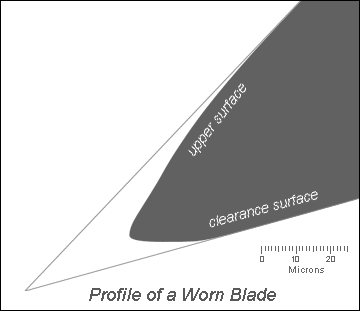
- The upper surface is what the shaving slides along as it leaves the throat of the plane. On a bevel-down plane, this corresponds to the back of the blade.
- The clearance surface travels just above the newly planed wood. On a bevel-down plane the clearance surface is on the bevel side of the blade.
Using a 540 power microscope to examine shoulder plane blades I’ve been able to make images of the shape of blade profiles at various stages of wear. The image above was made from a microscope image taken after the blade had planed 400 lineal feet of cherry, taking shavings between .0015 and .002” thick.
My microscope images of worn edges show a bright line on the clearance surface that grows as the blade becomes duller. The width of this bright line is a good measure of blade wear.
The width of this wear surface is used by Leitz, a major manufacturer of industrial blades, as an indicator for when a blade needs sharpening. For blades used in power equipment such as planers and shapers Leitz recommends sharpening when the wear surface reaches .2 mm (200 microns) in width. This amount of wear is much greater than the amount acceptable for a plane blade. I consider a smoothing plane blade ready for sharpening when the wear area on the clearance surface reaches about 12 microns in width.
While the bright line on the clearance surface is a good indicator of wear, the wider bright line that develops on the upper surface is not. The width of this line shows the thickness of the shaving being taken and even on a blade that is still quite sharp the shaving can leave a visibly polished area of the upper surface. The width of this bright area will remain almost the same as the blade becomes more worn.
For images of a test in which I looked at the upper and lower wear surfaces of the edge as well as its profile, click here.
As a blade becomes increasingly worn the shape of the edge profile changes. In the early stages of wear metal is lost primarily from the upper surface of the blade where the shaving is deflected upward. The tip also starts to become somewhat rounded. As wear increases an area on the clearance surface starts to experience significant abrasion as it slides against the planed surface of the workpiece. This area of negative clearance is a good measure of blade wear because it is loss of clearance rather than tip bluntness that is the major cause of decreasing performance in hand planing.
Here is a diagram that shows how the shape of the edge profile changes as wear increases. These profiles are derived from microscope images of a test in which a shoulder plane was used to take 3/8” wide shavings in cherry. Taking such narrow shavings allowed the test to continue past the point where a wider blade would become difficult to use.
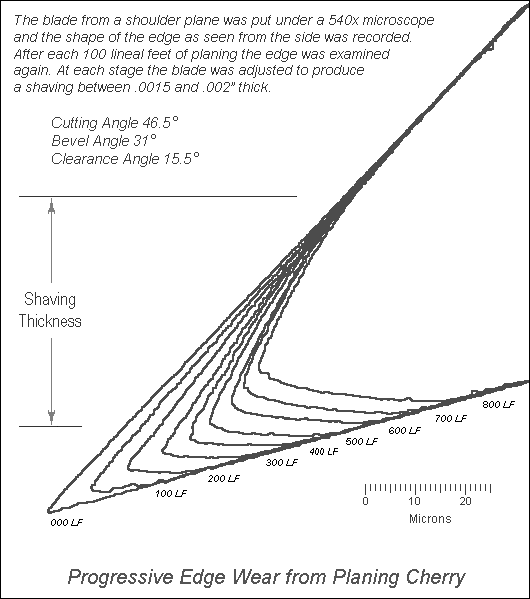
The results from the same test are presented differently in the next diagram which is intended to show the increasing loss of clearance.
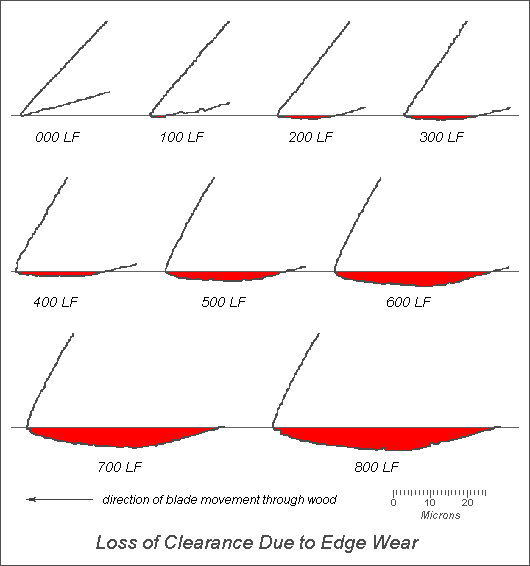
Rounding of the blade tip decreases edge sharpness and contributes to loss of quality of the planed surface but it is loss of clearance behind the blade that makes the plane balk at remaining in the cut.
Most published images of worn edge profiles show a shape similar to this one:
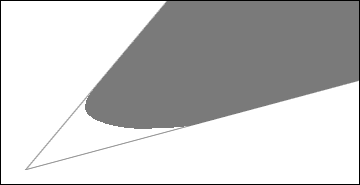
This shows the tip of the blade to be close to the upper surface, which is typical for the larger amount of wear found in blades used in power equipment. The illustration in R. Bruce Hoadley’s book Understanding Wood labeled “stages of dulling” shows this rounded edge receding along the upper surface of the blade as it does for blades with large amounts of wear. For the much smaller amounts of wear that result from hand planing this is a misleading picture.
In a study of wear profiles by Chutaro Kato and John A. Bailey a profilometer with a stylus was used to trace the shape of worn edges. The shapes of blades in the early stages of wear were similar to this one from one of my tests:
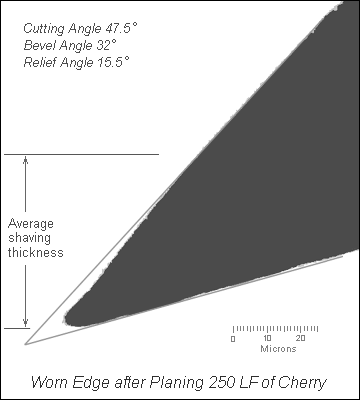
Most of the wear at this stage is from the upper surface of the blade. The slightly concave area just behind the blade tip is a feature that disappears as wear progresses.
This focus on loss of metal from the upper and lower surfaces would be merely academic if it didn’t affect sharpening strategy. Producing a new sharp edge can be done by removing steel from the bevel only or from both the bevel and the blade back. Efficient sharpening depends on removing the minimum amount of steel to recreate the original edge geometry.